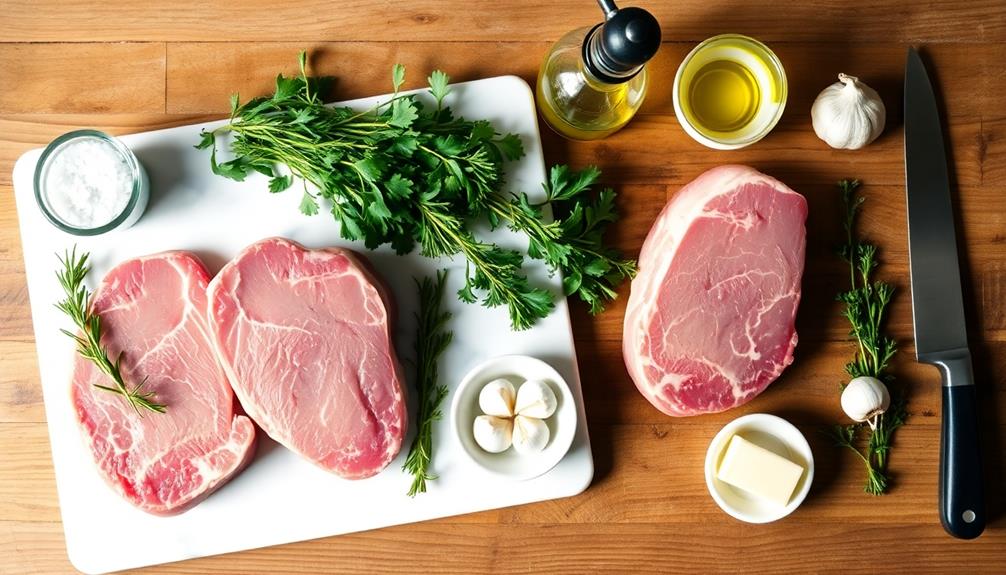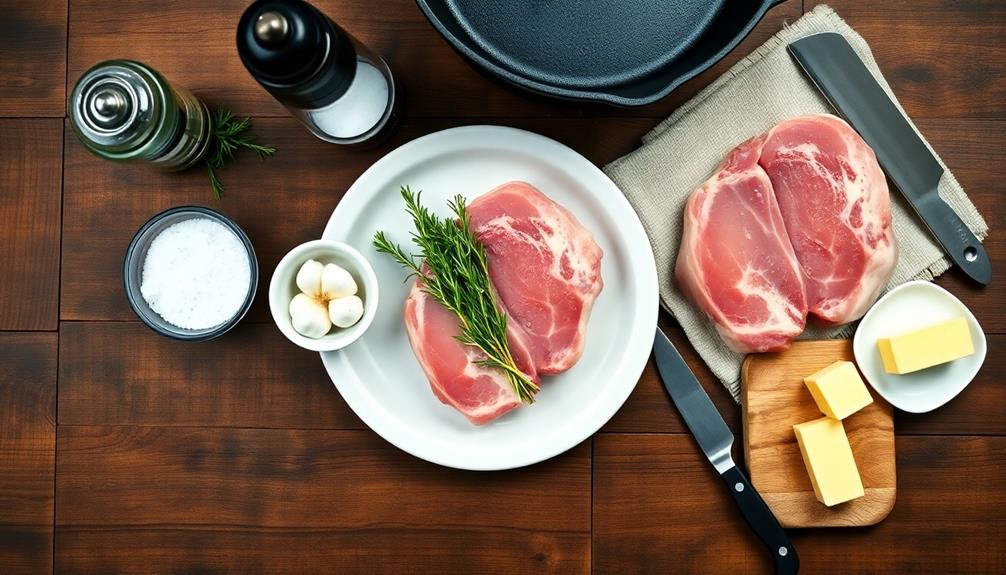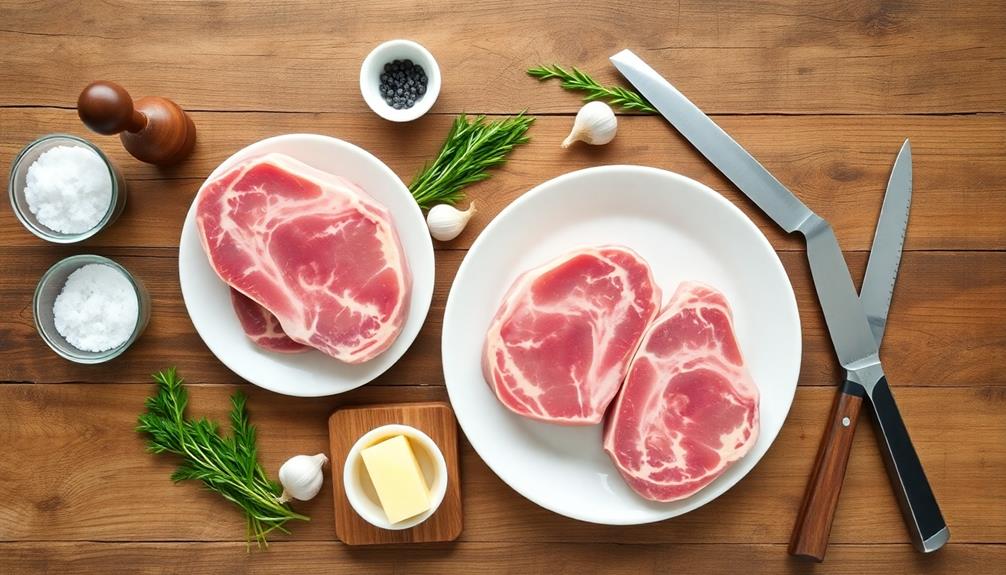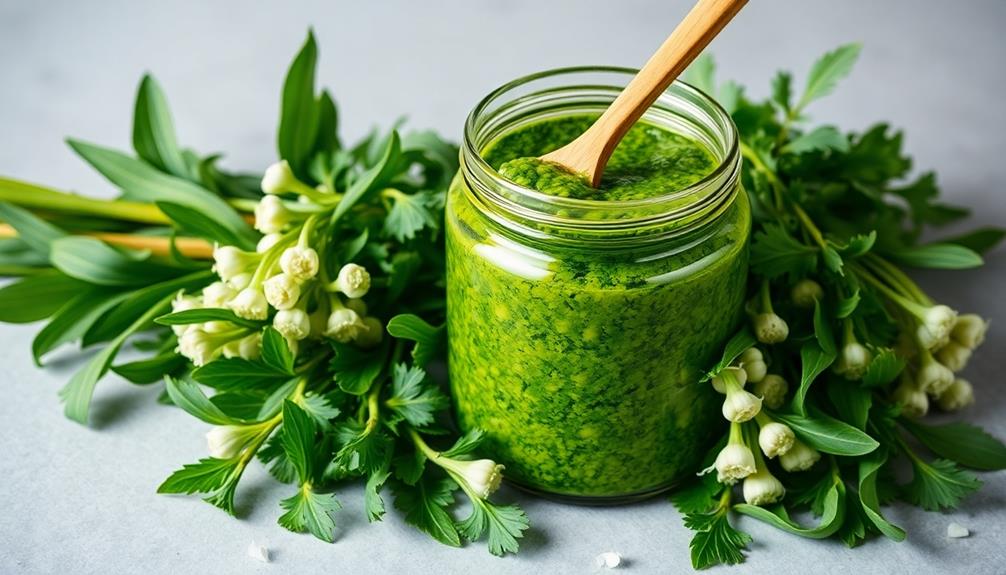Heritage pork chops offer a delicious twist on traditional pork. They come from older pig breeds raised outdoors, resulting in meat that's more flavorful and juicy than conventional pork. To cook them, start by seasoning with salt, pepper, and herbs. Sear the chops in a hot skillet for 3-4 minutes per side, then finish in a 400°F oven until they reach 145°F internally. Let them rest for 5 minutes before serving. Remember to use a meat thermometer for perfect doneness. You'll love the rich taste and tender texture of these ethically-raised chops. There's so much more to discover about this premium cut of pork.
Key Takeaways
- Heritage pork chops come from traditional pig breeds and offer richer flavor and more marbling than conventional pork.
- Cooking methods for heritage pork chops typically involve pan-searing and oven-roasting to achieve a crispy exterior and juicy interior.
- Heritage pigs are raised outdoors with ample space, emphasizing animal welfare and sustainable farming practices.
- Ideal internal temperature for cooked heritage pork chops is 145°F (63°C), followed by a 5-minute rest for optimal juiciness.
- Heritage pork chops are versatile and can be seasoned with various herbs and spices, making them suitable for special dinners or elevated weeknight meals.
History
Pork chops have been a staple in American cuisine for generations, but the concept of "heritage pork" is a relatively recent development. You might be wondering what sets heritage pork apart from the pork you're used to buying at the grocery store. Well, it's all about the pig breeds and how they're raised.
In the mid-20th century, most pork production shifted to focus on lean meat, which led to the use of modern pig breeds. These pigs grow quickly and produce leaner meat, but some say they lack flavor. That's where heritage pork comes in. It's from older, traditional pig breeds that were common before industrial farming took over.
You'll find that heritage pork has a richer flavor and more marbling. These pigs are often raised outdoors and given more space to roam. They're also allowed to grow more slowly, which contributes to their unique taste.
While heritage pork wasn't widely available for many years, it's now making a comeback as people seek out more flavorful and ethically raised meat options.
Recipe
Heritage pork chops are a culinary delight, known for their superior flavor and tenderness compared to conventional pork. These chops come from heritage breed pigs, which are raised using traditional farming methods that prioritize animal welfare and sustainable practices. The result is a more flavorful and juicy cut of meat that deserves special attention in the kitchen.
Coffee enthusiasts can also appreciate the unique flavors found in various coffee varieties, enhancing their overall dining experience.
This recipe for heritage pork chops showcases the natural flavors of the meat while adding a complementary blend of herbs and spices. The cooking method involves a combination of pan-searing and oven-roasting to achieve a perfect balance of crispy exterior and juicy interior. This dish is perfect for a special dinner or when you want to elevate your weeknight meal.
- 2 heritage pork chops (1-inch thick)
- 2 tablespoons olive oil
- 2 cloves garlic, minced
- 1 tablespoon fresh rosemary, chopped
- 1 tablespoon fresh thyme, chopped
- 1 teaspoon sea salt
- 1/2 teaspoon freshly ground black pepper
- 1 tablespoon unsalted butter
Preheat the oven to 400°F (200°C). Pat the pork chops dry with paper towels and season both sides with salt and pepper. Heat olive oil in an oven-safe skillet over medium-high heat. Add the pork chops and sear for 3-4 minutes on each side until golden brown.
Add minced garlic, rosemary, and thyme to the skillet, then transfer it to the preheated oven. Roast for 6-8 minutes or until the internal temperature reaches 145°F (63°C). Remove from the oven, add butter to the skillet, and baste the pork chops with the melted butter and herb mixture. Let the chops rest for 5 minutes before serving.
For best results, bring the pork chops to room temperature before cooking. This ensures even cooking throughout the meat. Avoid overcooking, as heritage pork is leaner and can dry out quickly. Use a meat thermometer to check for doneness, and remember that the temperature will continue to rise slightly during the resting period.
Experiment with different herbs and spices to create your own flavor combinations that complement the rich taste of heritage pork.
Cooking Steps
To cook your heritage pork chop, you'll start by preheating your oven to 400°F and seasoning the chops generously.
Next, you'll sear the chops in a hot skillet to develop a flavorful crust before transferring the skillet to the oven.
Once cooked through, you'll let the chops rest briefly before serving, ensuring they're juicy and delicious.
Step 1. Preheat Oven to 400°F

Before you begin preparing your heritage pork chop, it's crucial to preheat your oven to 400°F. This step ensures your oven is at the right temperature when you're ready to cook.
Turn on your oven and set it to 400°F, then give it time to heat up fully. This usually takes about 15 to 20 minutes, depending on your oven.
While you wait, you can start getting your other ingredients and tools ready. It's a good idea to use this time to season your pork chop or prepare any side dishes.
The preheating process is important because it helps your pork chop cook evenly and develop a nice crust on the outside while staying juicy on the inside.
If your oven has a preheat indicator, wait for it to signal that it's ready. If not, you can use an oven thermometer to check the temperature.
Once your oven reaches 400°F, you're all set to start cooking your heritage pork chop. Remember, starting with a properly preheated oven is key to achieving the best results with your dish.
Step 2. Season Pork Chops Generously

With your oven preheating, it's time to focus on seasoning your heritage pork chops. Take the chops out of the refrigerator and pat them dry with paper towels. This step helps the seasoning stick better and promotes a nice crust when cooking.
Now, grab your favorite seasonings. Salt and black pepper are must-haves, but don't be afraid to get creative. You can add garlic powder, dried herbs like thyme or rosemary, or even a pinch of smoked paprika for extra flavor. Sprinkle the seasonings generously on both sides of the pork chops, gently pressing them into the meat.
Don't hold back on the salt – it's key to bringing out the pork's natural flavors. A good rule of thumb is about 1/2 teaspoon of salt per pound of meat. Make sure you season the sides of the chops too, not just the flat surfaces.
If you're using thick-cut chops, you might want to use a bit more seasoning to ensure every bite is flavorful. Let the seasoned chops rest at room temperature for about 15 minutes before cooking. This allows the flavors to penetrate the meat and helps it cook more evenly.
Step 3. Sear Chops in Hot Skillet

Once your seasoned pork chops have rested, it's time to sear them in a hot skillet.
Heat a large, heavy-bottomed skillet over medium-high heat. Add a tablespoon of oil with a high smoke point, like vegetable or grapeseed oil. When the oil starts to shimmer, it's ready for the chops.
Carefully place the pork chops in the hot skillet. You'll hear a sizzle as they hit the pan. Don't overcrowd the pan; work in batches if needed.
Let the chops cook undisturbed for about 3-4 minutes. This allows a nice golden-brown crust to form. Using tongs, flip the chops and sear the other side for another 3-4 minutes.
If your chops are thick, you might need to finish cooking them in the oven. For thinner chops, they may be done after searing. Use a meat thermometer to check the internal temperature. It should reach 145°F (63°C) for medium-rare.
Step 4. Transfer Skillet to Oven

After searing your pork chops, you may need to finish cooking them in the oven, especially if they're thicker cuts. This method ensures they're cooked through without burning the outside.
First, make sure your skillet is oven-safe. If it's not, transfer the chops to a baking dish. Preheat your oven to 375°F (190°C) while you're searing the chops.
Once you've seared both sides, carefully move the skillet to the preheated oven. Use oven mitts, as the handle will be very hot. Cook the chops for about 5-10 minutes, depending on their thickness. For a 1-inch thick chop, aim for about 7 minutes.
To check if they're done, use a meat thermometer. It should read 145°F (63°C) when inserted into the thickest part of the chop. If you don't have a thermometer, cut into the center. The meat should be slightly pink but not raw.
Step 5. Rest and Serve Chops

The sizzling pork chops are ready to rest after their journey through skillet and oven. Carefully remove the skillet from the oven using thick oven mitts. Place the chops on a clean plate or cutting board, and let them rest for about 5 minutes.
This resting time is crucial as it allows the juices to redistribute throughout the meat, ensuring each bite is moist and flavorful.
While the chops rest, you can prepare your side dishes or set the table. Once the resting time is up, it's time to serve your perfectly cooked heritage pork chops. Use a sharp knife to cut into the thickest part of a chop. You'll see it's cooked through but still juicy.
If you've used a bone-in chop, the meat near the bone might be slightly pink, which is normal and safe to eat.
Plate your pork chops with your chosen sides. You can garnish with fresh herbs like parsley or thyme for extra flavor and a pop of color.
Don't forget to drizzle any pan juices over the meat for added taste. Serve immediately and enjoy your delicious, home-cooked meal!
Final Thoughts
Savoring a perfectly cooked heritage pork chop is an experience that'll linger in your memory.
You've now learned the art of preparing this delicious cut of meat, from selecting the right chop to resting and serving it.
Remember, the key to success lies in the details: choosing a quality heritage pork chop, brining it for enhanced flavor and tenderness, and cooking it to the right internal temperature.
Don't be afraid to experiment with different seasonings or marinades to suit your taste.
As you become more comfortable with the process, you'll find your own preferred methods and flavors.
Always prioritize food safety by using a meat thermometer and handling raw pork properly.
Cooking heritage pork chops isn't just about following a recipe; it's about understanding the meat and respecting its quality.
With practice, you'll develop an intuition for cooking times and temperatures.
Share your newfound skills with friends and family, and enjoy the satisfaction of serving a restaurant-quality meal right from your own kitchen.
Happy cooking!
Frequently Asked Questions
What Breeds of Pigs Are Considered Heritage for Pork Chops?
You'll find several heritage pig breeds for pork chops. These include Berkshire, Duroc, Tamworth, and Gloucestershire Old Spots. They're known for their superior flavor and marbling. Consider trying these breeds for a truly exceptional pork experience.
How Does Heritage Pork Taste Compared to Conventional Pork?
You'll notice heritage pork has a richer, more complex flavor than conventional pork. It's often described as juicier and more tender, with a better fat-to-meat ratio. You'll likely taste subtle nuances that aren't present in standard pork.
Where Can I Purchase Heritage Pork Chops?
You can find heritage pork chops at specialty butcher shops, farmers' markets, and high-end grocery stores. Try online retailers specializing in artisanal meats or directly from heritage breed farms. Some restaurants also offer heritage pork dishes you can sample.
Are Heritage Pork Chops More Expensive Than Regular Pork Chops?
You'll typically find heritage pork chops are pricier than regular ones. They're known for superior flavor and quality, which drives up the cost. However, prices can vary, so it's worth comparing at different retailers.
What Are the Nutritional Differences Between Heritage and Conventional Pork Chops?
You'll find heritage pork chops generally have a higher fat content and more marbling than conventional ones. They're often richer in omega-3 fatty acids and contain slightly more protein. However, specific nutritional differences can vary between breeds and farming practices.










